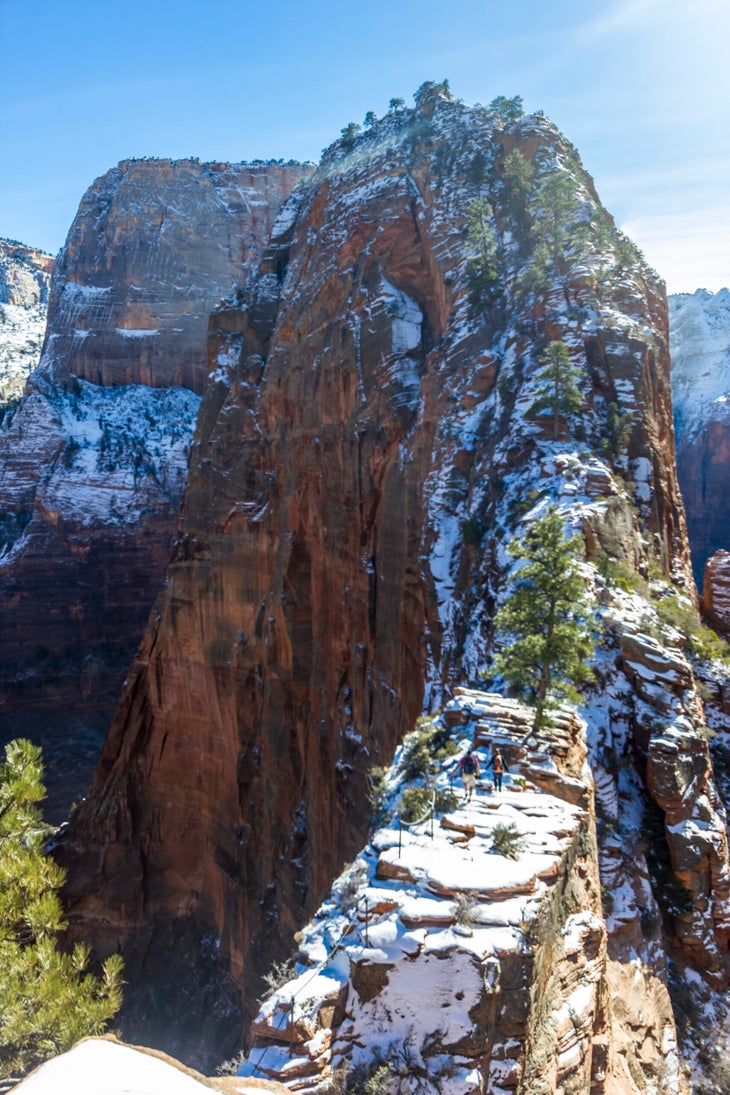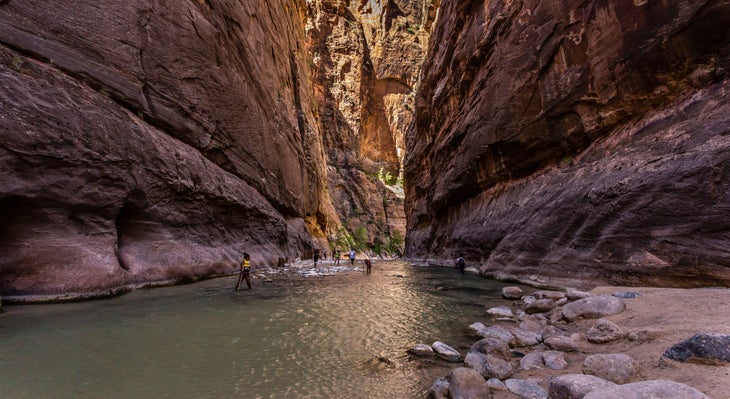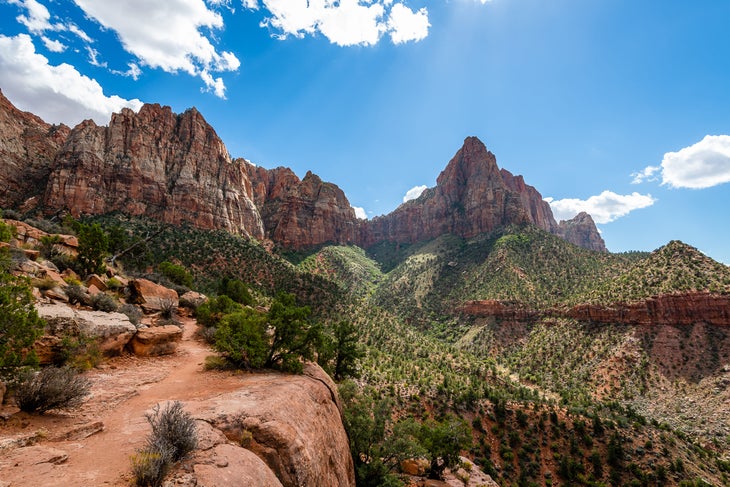Heading out the door? Read this article on the new Outside+ app available now on iOS devices for members! Download the app.
Sign up for Outside+ today to get access to everything Backpacker publishes, plus other great benefits like a subscription to Gaia GPS, print magazines, event invitations, and more.
When the weather on most hiking trails starts to turn cold, the desert is just hitting its stride. Zion is the place to be in the fall, with highs in the 70s, lows in the 40s, and an average of just two weeks of rain in September, October, and November combined. The hiking is good, too: With five distinct trail regions in the park to choose from, you won’t have trouble finding a spot even when the park is crowded. From beginner-friendly canyon rambles to a 50-mile traverse of the highest terrain in the park, these are the best trails in Zion.
Dayhikes in Zion

Whether you’re base-camping with all the luxuries you can fit into your car or just passing through for a day, a good dayhike can give you a taste of all Zion has to offer in the space of a few hours.
The Classic Zion Hike: Angel’s Landing
This hike is one of the most sought-after bucket list spots in the country, and for good reason: Between the views at the top and the wild climb to get there, it’s an experience like no other. Located in the southeast corner of the park, the trail climbs through the Virgin River gorge, passing through the 270-million-year-old Kayenta and Navajo sandstone layers. At 5 miles round-trip, the trail isn’t the longest, but 1,488 feet of elevation gain and occasional sections of scrambling make it a strenuous climb. The last stretch, with a path at times only 2 feet wide and with drops of a thousand feet to either side, isn’t for the faint of heart; but the summit rewards with a 360-degree panorama of canyons green with pinyon and juniper, colorful sandstone cliffs climbing thousands of feet from the canyon floors, and the occasional glint of a distant river. Downside: A classic like this comes with a crowd. Starting in March 2022, hikers will be chosen by permit lottery.
Best Hike for Kids: Double Arch Alcove
Zion’s Kolob Canyons region is less-visited than the rest of the park, but no less spectacular. This 5.2 mile out-and-back splashes through a small creek, wanders through red-rock canyons, and ends with a pair of sandstone arches and hanging gardens. And all of that comes with mellow enough elevation change that the whole family can enjoy it. The trail starts by following Taylor Creek, hopping across the water periodically, before heading into a true red-rock canyon around a mile and a half in. There’s some history on the trail, too: Two historic cabins built by homesteaders in the 1930s still stand at miles 1.1 and 2.1.
Quick Stop: Riverside Walk

The Riverside walk packs hanging gardens, a desert swamp, the Virgin River, and even a brief bit of the Narrows (the thinnest part of the entire park’s canyon system), all in just 2 miles. The trail starts at the Temple of Sinawava shuttle stop, then winds along the east bank of the Virgin River to the edge of the narrows. Hanging gardens on the sandstone cliffs along the way stay green thanks to water from the “seep line”, the point where the porous sandstone of the Navajo Formation and the denser Kayenta Formation shale meet. Bonus: The trail is wheelchair accessible.
Weekend Overnights at Zion

Ready to spend a night in the desert? Zion has plenty of options. Whether you want to spend two days following a slot canyon or trace the edge of a mesa high above, there’s no shortage of captivating weekend trips here.
Slot Canyon Experience: The Narrows
This 16-mile point-to-point heads through one of the most impressive river gorges on the planet. With 2,000-foot sandstone walls on either side, sometimes with just 20 feet between them, it is a true slot canyon. Much of the hike is in the Virgin River itself, as there is no shoreline or sandbars between the canyon walls, though in other places the gorge widens enough to accommodate small stands of trees and hanging gardens. There are 12 campsites within the canyon (wilderness permit required); experienced hikers can use the extra time gained from doing the narrows as an overnight rather than a long day hike to explore side canyons and springs. Be prepared to wade or even swim for significant sections of the canyon, and always check the forecast before heading in to avoid flash floods.
Canyon Rim Hike: West Rim Trail
Meadows, forest, stretches of open sandstone, canyon descents: This weekend route packs in a bit of everything. After starting in woods often frequented by deer, the path enters a meadow (filled with wildflowers in spring and summer). The first campsites on the route are here, around mile 5. The next section climbs back into forest before emerging into the meadowed uplands of Horse Pasture Plateau, with views across the rest of the park’s mesas, canyons, and redrock towers. At mile 9, the route drops off the east edge of the plateau and crosses a section of open stone before switchbacking down into Refrigerator Canyon, then dropping all the way to Zion Canyon’s floor. The 14.6-mile point-to-point finishes at the Grotto Trailhead.
Multiday Trips in Zion

When a weekend just isn’t enough—or you’re finally taking your vacation time and ready to spend a week deep in the desert and out of reach—check out one of these adventurous long routes through Zion National Park.
Total Traverse: Lee Pass to East Rim
Have a week and want to see the entire park? Cross the whole thing from north to south on this 47-mile point-to-point. Starting at Lee Pass, at the northern edge of the park, cross Kolob Canyons and Hop Valley. After that stretch of redrock canyons and hidden hanging gardens, climb to the highest points in the park (over 7,000 feet) by linking with the West Rim Trail. This stretch passes through a spot called Little Siberia that holds snow from November to May. Drop back into the sandstone formations below with a precipitous descent on narrow cliffside switchbacks to Zion Canyon. The trail finishes up on the East Rim with a climb past a slot canyon waterfall at Jolly Gulch.
Permits
Overnight camping in the park requires a wilderness permit ($15 for 1-2 people, $20 for 3-7, and $25 for 8-12), half of which are reservable in advance. The other half of available permits are first-come, first-serve, and can be obtained at visitor centers inside the park.
Hiking Tips for Zion National Park
Watch the weather.
Especially in slot canyons like the narrows, flash floods are a serious risk. Check the weather for both the area you’ll be hiking in and the catchment basins upstream for several days around your planned hiking time, and check out our canyoneering guide to know what to look for.
Bring plenty of water.
On any desert hike, water is your most precious resource. Many hikes in Zion don’t have water sources (or the water sources are home to toxic algae blooms), so be prepared to carry a lot of water weight. This is one thing you don’t want to skimp on, though; bringing enough water could mean life or death in the Zion backcountry.
If you’re going into The Narrows, make sure to waterproof your gear.
The Narrows, and several other similar slot canyons, require wading or even swimming. Double-bag your sleeping bag, line your pack with a trash bag, and make sure your dry bags and other waterproof systems are working before heading into the backcountry.
Tell someone where you’re going.
This is important for any hike, but the desert can be particularly unforgiving to stranded backpackers. Make sure someone you trust knows where you’re going and when you expect to be back.
Bring warm layers.
In fall and spring, even the valleys in Zion can easily drop below freezing, despite daytime temps in the 70s. Bring warm layers and a sleeping bag rated to at least 30 degrees.
From 2025
